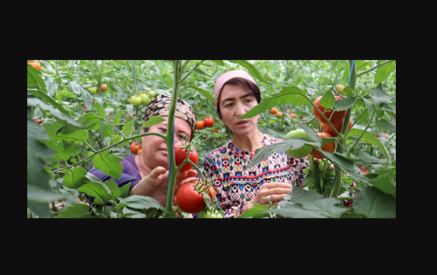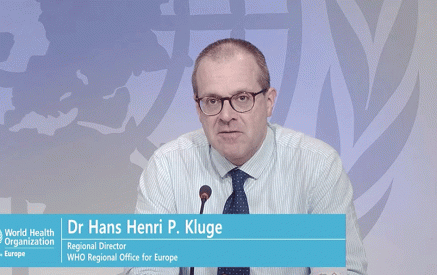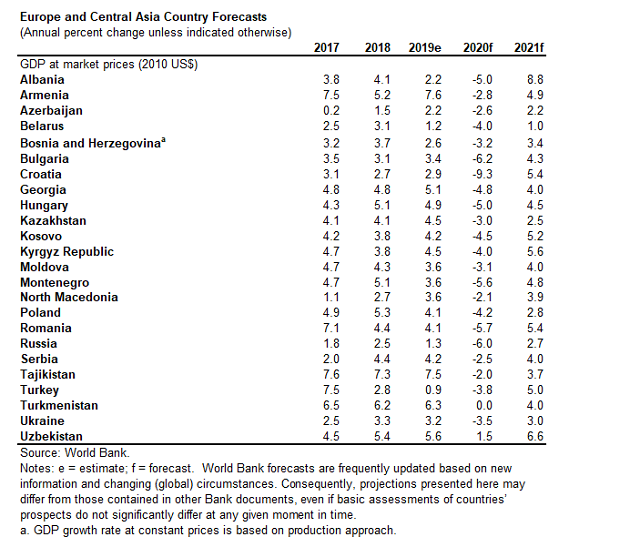Recent developments: The COVID-19 pandemic has adversely affected Europe and Central Asia through the collapse in global commodity prices, disruptions to global and regional supply chains, and heightened risk aversion in financial markets. The widening of domestic outbreaks of the virus has steepened the decline in domestic demand, exacerbated supply disruptions, and brought much activity to a halt.
Economies in the region have experienced substantial flight-to-safety outflows and a rise in bond spreads. Weaker currencies have contributed to higher borrowing costs, and current account pressures have been exacerbated by a collapse in exports.
Many of the region’s central banks have responded to the crisis by ramping up monetary support, and authorities have intervened in foreign exchange markets to stabilize their currencies and mitigate volatility, such as in Kazakhstan, or have used sovereign wealth funds to do so, such as in Azerbaijan and the Russian Federation.
While fiscal policy options are limited in many countries, policymakers have used existing buffers or prioritized spending on health care, social safety nets, support for the private sector, and to counter financial market disruption. While a number of countries have announced fiscal support packages, many economies were ill prepared for the pandemic given limited health care capacity.
Read also
Outlook:The regional economyis forecast to contract by 4.7%, with recessions in nearly all countries. The outlook assumes that government restrictions are gradually lifted by the start of the second half of the year. In a scenario in which the effects of the pandemic wane and trade and investment recover, Europe and Central Asia growth would be anticipated to revive to 3.6 percent in 2021.
Economic activity in the region is vulnerable to global spillovers due to its openness to trade and financial flows, including remittances. In addition, for energy exporters in the region, which include Russia, Kazakhstan and Azerbaijan, continued low oil prices are expected to weigh on growth.
Russia’s economy is forecast to contract by 6% this year, reflecting a jump in COVID-19 cases and the collapse in oil prices. Turkey’s economy is anticipated to shrink by 3.8% this year, subject to shutdowns and continued weakness in investment.
Economic activity is expected to contract in every sub-region in 2020 as outbreaks of the virus constrain private consumption and investment: Central Europe by 5%; Western Balkans by 3.2%; South Caucasus by 3.1%; Eastern Europe by 3.6%; and Central Asia by 1.7%.
The impact on economic activity is highly uncertain and could be more severe if the pandemic and the associated collapse in activity worsen. Hardest hit would be economies with strong trade and financial linkages, including remittances, to the Euro Area or Russia.
Risks: The balance of risks leans heavily to the downside. A greater spread of infections across the region and associated restrictive measures would weigh even more harshly on consumption and investment. In addition, a sharp fall in remittances could amplify the regional economic downturn.A prolonged recession could negatively affect domestic financial sectors and heighten the risk of financial instability. A protracted deterioration in investment sentiment could lead to a substantial decline in foreign direct investment. Regional weather patterns, including the drought that is affecting economies in Eastern Europe and the Western Balkans, also pose a downside risk to the forecasts.
Download Global Economic Prospects
World Bank Group COVID-19 Response
“The World Bank Group, one of the largest sources of funding and knowledge for developing countries, is taking broad, fast action to help developing countries strengthen their pandemic response. We are supporting public health interventions, working to ensure the flow of critical supplies and equipment, and helping the private sector continue to operate and sustain jobs. We will be deploying up to $160 billion in financial support over 15 months to help more than 100 countries protect the poor and vulnerable, support businesses, and bolster economic recovery. This includes $50 billion of new IDA resources through grants and highly concessional loans.”
World Bank Yerevan Office
























































